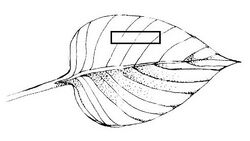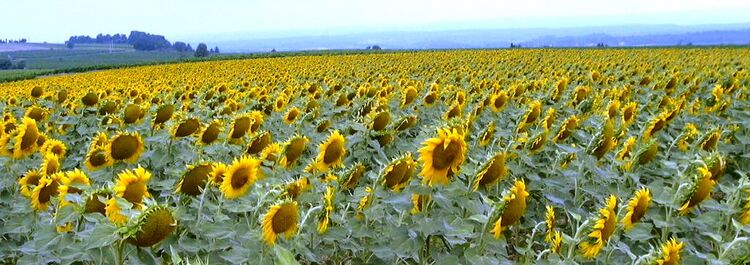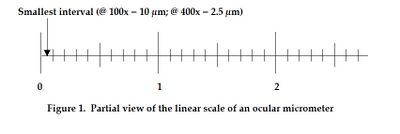Lab 3: Plant Anatomy
Objectives
- Generate hypotheses about leaf and stomatal structure of plants.
- Test those hypotheses by quantifying leaf anatomy and stomatal size and distribution.
Lab 3 Overview
I. Formulate Hypotheses about Plant Anatomy
II. Test Hypotheses about Plant Anatomy
- a. Stomatal Anatomy Using Epidermal Peels
Stomatal Distribution (top/bottom/total)
Stomatal Counts
Stomatal Length
- b. Cross sectional Anatomy of Leaf Using Hand Microtomes
Total Leaf Thickness
Mesophyll Thickness
Calculate Epidermal Thickness
Plant Morphology: Background
Today, we will study plant habit and leaf morphology/anatomy, which will help your understanding of various aspects of plant form and function. There are many aspects of plant and leaf morphology/anatomy that may affect the plant's ability to function in its environment.
Epidermal tissue The epidermal tissues of leaves serve a number of key functions: (a) to regulate gas exchange, (b) to prevent excessive water loss, (c) to defend against disease and predation (d) to screen out harmful ultraviolet light. The epidermis is the outermost covering of the leaf. These cells generally lack chloroplasts. They are packed tightly together and sealed with a waxy coating called the cuticle. This tight packing and wax seal serve to prevent water loss and to stop bacteria and viruses from penetrating the outer surface.
During the period of leaf growth and maturation some epidermal cells differentiate into a complex of cells that regulates the flux of gases (CO2, H2O, O2) into and out of the leaf. Gas-regulating complexes of cells are referred to as stomatal complexes. The cells that compose these complexes are called guard cells and subsidiary cells. They work together to regulate the opening and closing of pores in the epidermis. The subsidiary cells are easily recognized because they are morphologically different from the majority of the other epidermal cells and directly border the guard cells. The pores are called stomata (singular: stoma) and it is through these pores that the movement of gases (e.g. CO2 and H20 vapor) occurs.
Mesophyll Tissue The ground tissue of the leaf consists of parenchyma cells, which in this case have the specialized names, palisade and spongy mesophyll. Parenchyma is a general term used by plant biologists to refer to the thin walled living cells that form much of the ground tissues in all plant organs. It is between the leaf’s upper and lower epidermis that we find the chloroplast containing palisade and spongy mesophyll cells that perform the main function of the leaf, photosynthesis.

Fig. 4.1. Leaf cross-sections (left) and stomata (right) of angiosperms.
Making Epidermal Peels and Measuring Stomatal Densities
Duco cement epidermal peels are like impressions of the leaf surface topography and will reveal the surface of the epidermis and its stomata. Each person will apply a thin layer of cement (not more than 1-2 cm wide) to both the upper and lower surface of selected leaves while they are attached to the plants. Try to select a leaf from each plant that is mature and of similar age and size-not too young or too old. For each replica use a toothpick to place the duco cement on the leaf blade avoiding the mid-vein and the edge of the leaf. Allow the cement to dry for about 5 min. Peel off the transparent cement layer with forceps and mount a small section of it in water on a slide and place it under a cover slip.
When observing the stomatal imprints on the replicas under the compound microscope you will need to maximize image contrast. Do this by reducing light intensity and close down your iris diaphragm located on the substage condenser. Depending on how small the stomata are and their density, you may choose to observe them at a total magnification of 100X or 400X. Always start with the lower power.
Taking pictures and keeping track of scale
Take pictures of an upper epidermis imprint. You may want to use the zoom function of the camera to get the clearest picture of the stomates. In one of the oculars of your microscope you will view a square grid superimposed on the microscopic image. Take photographs through the eyepiece of your microscope with the grid in order to keep track of scale. The grid is composed of 100 identical small squares. At a total magnification of 40 (objective x4) the side of one small square represents 250 µm; at 100 (objective x10) the side of a small square represents 100 µm; and at 400 (objective 40) it represents 25 µm. Always make sure to record the magnification used for your photographs.
Measurement of stomatal density (number of stomata mm2)
Draft a data table in your lab notebook to record your observations. Include Surface (lower or upper), Sample Number, # of stomata / 20 squares, and # of stomata / mm2.
![]()
At 100X count the number of stomata in the entire square grid, or, if you find the stomata too numerous, count the number of stomata in 20 contiguous small squares of the grid, and multiply by 5 to get an estimate for the entire grid. Repeat on the lower surface peel. NOTE: The stomata included under the whole grid at 100X total magnification represent the number of stomata in 1mm2. If you count the stomata under the whole grid at 400X total magnification multiply by 16 for the final number of stomata in 1mm2. If, at 400X, you count only 20 small squares of the grid you need to multiply by 5 and by 16 for the number of stomata per mm2.
- Calculate the number of stomata per mm2 for both the lower and the upper leaf surface.
- Sum the upper and lower to record total stomatal density in 1 mm2 of leaf area.
- Record your lower, upper, and total stomatal density data on the class data sheet.
- Post photographs in SAKAI. Post the best image of a stomatal peel taken through the eye piece of your microscope with the grid. Label the pictures indicating the name of the plant and the magnification as in the following example: Rhoeo-stomates-X100.jpg (or png). These images will be needed for your composite figure assignment.
Measuring Stomatal Length Using Epidermal Peels
We can measure the relative sizes or quantities of some of the structures and tissues present within the leaf. Because the measurements are of very small structures the light microscopes in the laboratory are equipped with ocular micrometers. An ocular micrometer looks like a small ruler with uniform intervals on the scale (Fig. 1). Depending on your microscope you will find the micrometer along one edge of the ocular grid or in the other ocular.
The smallest interval on the scale represents a specific distance. The exact distance depends on the objective lens that is being used to observe the specimen. The distance equivalent to the smallest interval on the micrometer for the 10X objective lens (100X total magnification with the 10X ocular) is 10 µm and for the 40X objective lens (400X total magnification) the distance is 2.5 µm. Therefore, if you are observing your structure at a total magnification of 100X and the distance spanned is 20 small intervals, the thickness of the mesophyll layer is calculated as:
Measurement of stomatal aperture length using lower leaf stomatal peels
Use the micrometer in the eyepiece. (In some of the microscopes the eyepiece(s)can be turned while others require that you turn the head of the microscope to move the micrometer).
Using the lower leaf Duco cement replicas, measure and record in your notebook the length of five different stomata using the ocular micrometer. Calculate the average of these 5 measurements and record the average in the lab data sheet. Calculate the average and standard deviation for stomatal length for each plant species using the pooled class data.
Calculating a Stomatal Conductance Index
Stomatal conductance, or the ability of materials to pass through the stomata of a leaf, is dependent on both the size of the stomata and the total density of stomata on the leaf (Holland and Richardson, 2009). This variable should relate to the rate at which water passed through the stomata of each plant during the transpiration lab.
Each student will calculate the stomatal conductance index for one leaf of their plant using the following formula:
Record your stomatal conductance index value.
Making a Cross Section of a Leaf
Draft a data table in your lab notebook to record your observations of leaf section anatomy. Include Sample number, mesophyll thickness (μm), and total leaf thickness (μm). Calculate epidermal thickness (μm).
You will be shown two methods for preparing cross sections. Select the one that works best for you.
Microtome method: Cut a piece of leaf about 1 cm long and 0.5 cm wide, so that it will fit into the well of the microtome.

2. Fill the lower portion of the well of the microtome with liquid paraffin and use forceps to place the leaf specimen vertically in the paraffin as quickly as possible, before the wax hardens. Once the leaf is held in place fill the well with additional parafilm.
3. Hold the leaf section until the paraffin hardens enough to keep the leaf section in place.
4. Once the paraffin hardens completely, about 5 minutes, use the microtome knife to shave the top of the plug to give a flat surface. Turn the bottom dial of the microtome to elevate the plug slightly and gently cut a thin section. Continue making sections until you have one thin enough to place on a microscope slide so the crossectional inner surface of the leaf is facing up, add a drop of water, and cover with a cover slip.
5. Use the micrometer in the ocular of your microscope to measure the entire thickness of the leaf, the thickness of the mesophyll, and calculate the thickness of the epidermis as the difference between the total thickness and mesophyll thickness.
6. Take pictures of a leaf cross-section through the ocular with the grid. Post your best image of a cross-section on SAKAI. Label the pictures indicating the name of the plant and the magnification as in the following example: Sunflower-cross-X100.jpg (or png).
Assignments
1. Create a composite figure with legend showing stomata and leaf cross-sections for the plant you studied. Add labels and scale bars on each photograph.
2. Construct a graph of all four species according to the directions of your instructor.
See the Statistics and Graphing link for tutorials explaining how to create/format a composite photo with figure caption and a column graph with error bars.
4. Take Pre-Lab quiz on Transpiration prior to next lab.
Other Labs in this Section
Lab 4: Transpiration in High Light/High Wind and Low Light/Low Wind Habitats
Lab 5: Rates of Photosynthesis in Response to Increasing Light Intensity
Lab 6: Group Oral Presentations

